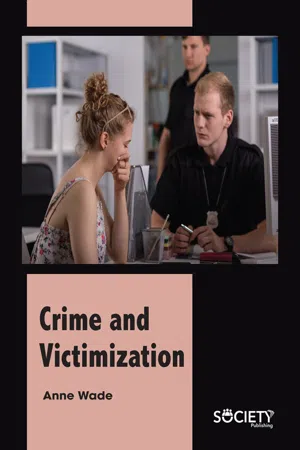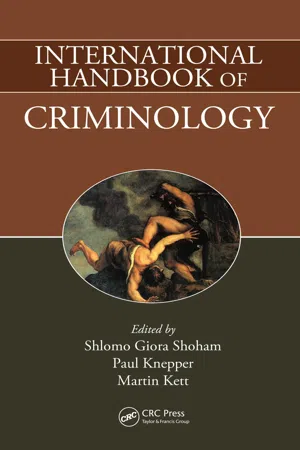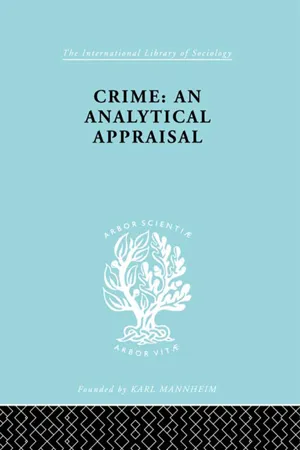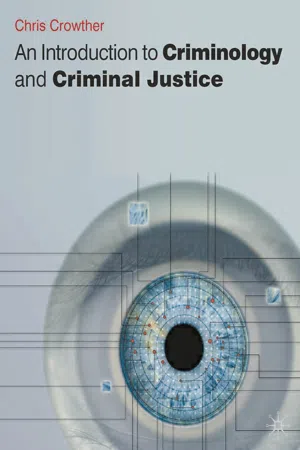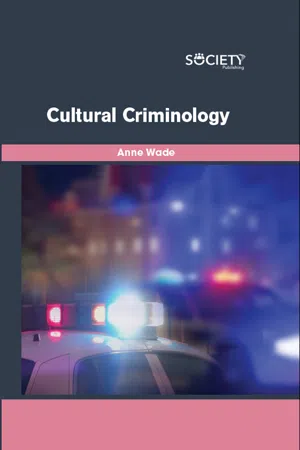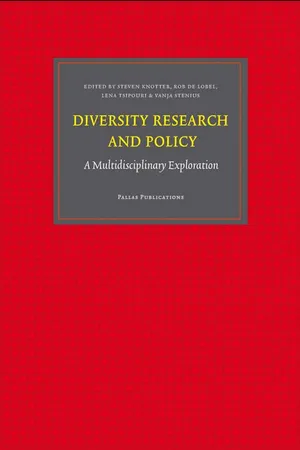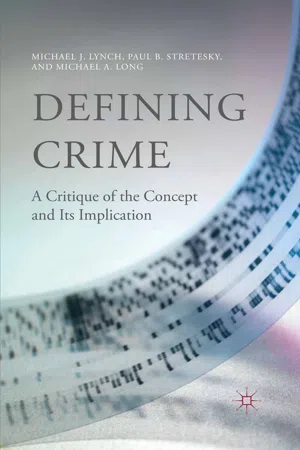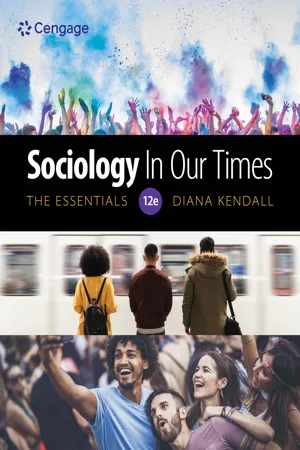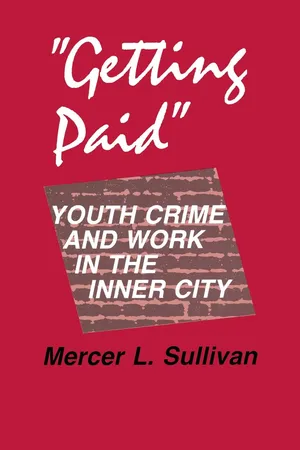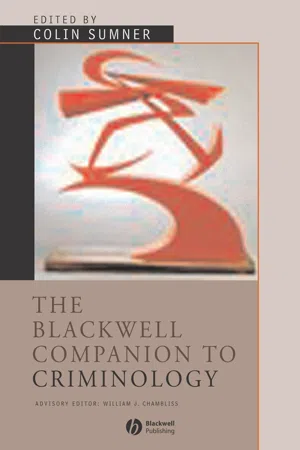Social Sciences
Social Class and Crime
Social class and crime refers to the relationship between an individual's socioeconomic status and their likelihood of engaging in criminal behavior. Research suggests that individuals from lower social classes are more likely to be involved in criminal activities due to factors such as limited opportunities, economic strain, and exposure to criminogenic environments. This connection between social class and crime is a key focus in criminology and sociology.
Written by Perlego with AI-assistance
Related key terms
1 of 5
12 Key excerpts on "Social Class and Crime"
- eBook - PDF
- Anne Wade(Author)
- 2020(Publication Date)
- Society Publishing(Publisher)
Social Class and Crime 16 CONTENTS 16.1. Introduction .................................................................................. 250 16.2. Socio-Economic Classes ............................................................... 254 16.3. Victimization, Lower Class, And Crime ......................................... 258 Crime and Victimization 250 16.1. INTRODUCTION All history has been a history of class struggles between dominated classes at various stages of social development.” Those were sentiments from one Friedrich Engels, a German philosopher who was widely known in the 19 th century for the alienation and exploitation of the normal worker. The sentiments depict a series of struggles where the strongest in the society would win. This theory largely showcases our current and modern world that is divided through social class and human inequality. It represents a natural situation that makes each human struggle to live up to survive (Figure 16.1). Figure 16.1. Friedrich Engels, one of the pioneers of identifying the effect of social class. Source: https://en.wikipedia.org/wiki/Friedrich_Engels. Social Class and Crime 251 Social class can be defined as the divisive nature or rather division of a society based on social and economic class. Social class traverses through various aspects putting in a gap or a bridge between sets of individuals or people. The term class is derived from a Latin word classis. This term was initially used by census takers to categorize citizens by wealth to determine their military service obligations. It divides people basing ion their position in the society. Social class relates to social sciences and is an aspect of anthropology, political theory, sociology, and social history. Social history defines how a society was divided long before, i.e., in the olden days and how the same community grew to where it is currently. - eBook - PDF
- Shlomo Giora Shoham, Paul Knepper, Martin Kett(Authors)
- 2010(Publication Date)
- Routledge(Publisher)
If social class is related to nontrivial criminal offending in these egalitarian societies, one would expect even stronger effects in nations with more intense levels of poverty. 19.3.2 Community Context of Class and Crime The self-report method can also be criticized for a narrow conceptualization of social class. Most self-report studies treat social class as an individual- or a family-level attribute, ignoring the fact that the community context of social disadvantage plays a critical role in many sociological explanations of crime [Shaw and McKay 1942; Sampson and Groves 1989; Blau and Blau 1982]. Research by Robert Crutchfield [1995; Crutchfield and Pitchford, 1997] suggests that the social structure of the residential area has a lot to do with the impact of a person’s social class on criminal offending. For example, mar-ginal labor market status does not appear to contribute to criminal behavior for individuals living in a suburban middle-class neighborhood. However, the consequences of unemployment are different if the same individual is embedded in a community with a critical mass of similarly situated peers: thus,“when they spend substantial amounts of time with other marginally employed people in bars, on street corners, or pool halls, they are more likely to be involved in crime” [Crutchfield, 1995:205]. Much of recent community-level research on Social Class and Crime has been motivated by the desire to understand why disadvantaged neigh-borhoods have more crime [Bellair, 1997 and 2000; Kubrin and Weitzer, 2003]. Blending elements from contemporary social disorganization theory [Sampson and Groves, 1989] and Coleman’s social capital theory [1990], the theory of collective effi cacy is a sophisticated example of this literature [Sampson, Raudenbush, and Earls, 1997]. Informal social control enacted under conditions of social trust is the key causal mechanism in this theory [Sampson, 2004]. - eBook - ePub
Crime
An Analytical Appraisal
- Manuel Lopez-Rey(Author)
- 2013(Publication Date)
- Routledge(Publisher)
2 Crime as a social problem
It has been shown that together unknown and known but unreported crime are more extensive and serious than reported crime. Therefore criminal statistics are not the only source of knowledge about crime; officials, authorities and highly placed persons, although unpunished, are frequently offenders; and, in the main, those responsible for reported crime are a socially, economically and psychologically well-defined group.The extent of crime and the variety of social groups involved refute the thesis that it can be explained by causal generalizations, or that as a problem it can be dealt with as part of socio-economic planning. In order to be understood, it must be viewed in the light of such an ensemble as socio-economic change, the structure of the general population, political organization and stability, and politico-social values.The persistence and widespread increase of crime, in spite of all efforts to reduce it, raise a series of questions about the necessity for a new approach to the prevention of crime and the treatment of offenders; the effectiveness of criminal justice and the need to review the system of values it protects; as well as the validity of the distinction between crime and delinquency.All these questions show clearly the socio-political character of crime, both as a general and as an individual event; it is essentially a policy problem and should be dealt with as such. Scientific findings should be used within the limits imposed by political and policy considerations, among which respect for human rights is of primary importance. Owing to its complexity, crime defies scientific integration if this is understood as putting together all the parts in order to form a scientific whole.This puts crime in a different perspective which has not, up to now, been contemplated. Only recently has it been fully realized that the unknown territory of crime requires attention from a political and scientific point of view. It means that the criminal justice system should be organized so as to reduce the non-reported areas of crime, and that some of the pillars of contemporary research have to be abandoned and new ones built up. - Chris Crowther-Dowey(Author)
- 2017(Publication Date)
- Red Globe Press(Publisher)
So the capitalist system provides a structure within which crime is defined and dealt with. Second, class has a strong link with income. In crude terms, the working classes have less wealth than the ruling class, and the underclass have less wealth even than the working class. As we noted above, most (though not by any means all) offenders and victims are found in the underclass, and it can be argued that this is because of the income differentials in society. However, before we consider the underclass in more detail we need to introduce the thinking of Max Weber (1968). Many criticisms have been levelled at Marx over the years, and arguably his critics were right, given the collapse of communism in the Soviet Union. However long before this took place, Marx’s critics objected to his economic determinism, or his tendency to argue that the economy influenced everything that went on in all areas of society. Weber (1968) was among those who thought this was too simple. He introduced two other factors to explain the class structure and the workings of society: status and party. Party is not considered here, but we do need to review Weber’s ideas on class and status. ‘Class’ refers to economic factors such as property and markets, whereas ‘status’ relates to those differences between people that are based on cultural rather than economic factors. Both share a relationship with power. People of ‘high’ class have power because of their economic control, but people of ‘high’ status have power for wider reasons: their social standing in the community, and the role they play within it. In a nutshell, there are powerful and influential groups in society who do not simply represent economic interests, but are powerful because of the status attached to their role or function. Criminal justice agencies like the police and the courts are examples. The underclass The idea of an underclass has been around in one form or another for centuries (Crowther, 2000a; Devine et al., 2004).- eBook - PDF
- Anne Wade(Author)
- 2019(Publication Date)
- Society Publishing(Publisher)
The influence of cultural may be perceived as a process in which various elements are combined. Criminal activity has many motivators. One area of research that is becoming popular views crime as a product of culture or subculture. Enculturation has a significant bearing on development of criminal behavior . Research proves that there is a disparity in the rates of crime occurring in different cultures and subcultures. Crime is a complicated phenomenon and it cannot be explained by one theory alone. Multitude of concepts is used to determine the origin of criminal behavior. The switch to free-market economy has led to many cultural changes, even at the individual level. This has caused a surge in crime rates. The reasons behind differences in crimes across various cultures are not fully explained yet. However, some individualistic and collectivistic cultures are at play. There are various factors that lead to an increase in crimes. This includes personal vulnerabilities like poor attachment, exposure to violence, lack of education opportunities, etc. Social disadvantages such as poverty, lack of education and poor influence of people further compounds these problems. Crime becomes a tool for criminals to achieve social capital which they cannot achieve by any other means. 2.2. CRIME A crime is an unlawful act or offense. It attracts punishment and is condemned by the society. The punishments range from fine to imprisonment. In the case of very serious crimes some countries award capital punishment though Crime and Justice: A Global Perspective 29 it is banned in man developed countries. Crimes are more serious than civil wrong or tort which refers to an action detrimental to another person. The wrongdoer has to compensate the affect person. This is known as restitution. Acts of crime are described by criminal law. Criminal law refers to set of federal and state rules that forbid actions the government considers detrimental to the interest of the society. - eBook - PDF
Foundations of theory-formation in criminology
A methodological analysis
- Catharina Irma Dessaur(Author)
- 2018(Publication Date)
- De Gruyter Mouton(Publisher)
Criteria of class are family member-ship, educational level, location of residence, type of house, church membership, club membership, size of income, prestige of occupation, manners, dress, speech. When mobility of persons between classes is highly restricted, sociologists apply the term caste. Castes are customarily based on race, birth, sex, sometimes on religion and inherited wealth. There are no absolutely closed castes (not even in India), but for persons with the wrong antecedents, the wrong race, the wrong sex, it may be virtually impossible to become a member of a certain caste. 8. Fr. Waismann, Wittgenstein und der Wiener Kreis, London 1967. 9. One should not compare so-called interdisciplinary behavioral research with the now customary interdisciplinary research in fundamental physical and natural sciences. The latter have a theoretical model (the atomic model) in common as their basic presupposition. But a common basic model for say Freudianism and 'differential association' is non-existent. It might even be proved to be principally unattainable, because of their contradictory images of man: the tamed animal whose anti-social instincts may break through anytime, versus the zoonpoliticon: the animal that is socially inclined by its very nature. 10. D. H. Chapman, Sociology and the Stereotype ofthe Criminal, London/New York 1968. 11. See, for instance, V. Aubert, 'White-Collar Crime and Social Structure', in: American Journal of Sociology, 58 (November 1952), pp. 263-271. Reprinted in Cressey and Ward, op. cit. To define upper-class deviant behavior legally as crime may be a symptom of social change. To make the enforcement of these new laws as slow and inefficient as possible, is on the other hand a symptom of resistance to social change. By creating new penal laws in this category and by not applying (or hardly applying) any sanctions, social peace is maintained. Both the social reformers and the establishment feel satisfied, Aubert writes. - eBook - PDF
Sociology
The Essentials
- Margaret L. Andersen; Howard F. Taylor, Margaret Andersen, Howard Taylor(Authors)
- 2016(Publication Date)
- Cengage Learning EMEA(Publisher)
Each perspective traces criminal behavior to social condi-tions rather than only to the intrinsic tendencies or personalities of individuals. ◆ Table 7.2 Sociological Theories of Crime Functionalist Theory Symbolic Interaction Theory Conflict Theory Societies require a certain level of crime in order to clarify norms. Crime is behavior that is learned through social interaction. The lower the social class, the more the individual is forced into criminality. Crime results from social structural strains (such as class inequality) within society. Labeling criminals and stigmatizing them tends to reinforce rather than deter crime. Inequalities in society by race, class, gender, and other forces tend to produce criminal activity. Crime may be functional to society, thus difficult to eradicate. Institutions with the power to label, such as prisons, actually produce rather than lessen crime. Reducing social inequality in society is likely to reduce crime. © Cengage Learning Some deviance develops in deviant communities, such as the neo-Nazis/“skinheads” shown marching here. Such right-wing extremist groups have increased significantly in recent years, as monitored by the Southern Poverty Law Center. Jim West/Alamy Copyright 2017 Cengage Learning. All Rights Reserved. May not be copied, scanned, or duplicated, in whole or in part. Due to electronic rights, some third party content may be suppressed from the eBook and/or eChapter(s). Editorial review has deemed that any suppressed content does not materially affect the overall learning experience. Cengage Learning reserves the right to remove additional content at any time if subsequent rights restrictions require it. 160 CHAPTER 7 Measuring Crime: How Much Is There? Is crime increasing in the United States? One would cer-tainly think so from watching the media. Images of vio-lent crime abound and give the impression that crime is a constant threat and is on the rise. - eBook - PDF
Diversity Research and Policy
A Multidisciplinary Exploration
- Steven Knotter, Rob de Lobel, Lena Tsipouri, Vanja Stenius, Steven Knotter, Rob de Lobel, Lena Tsipouri, Vanja Stenius(Authors)
- 2012(Publication Date)
- Amsterdam University Press(Publisher)
This latter consideration is important in that criminology is based on the occurrence of a phenomenon that is defined within a community or society. A behaviour or act (or failure to do something) does not constitute a crime until it is defined as such within the law and punishable in accordance with the law. This means that diversity in culture and social conditions may lead to markedly different laws and hence different notions of what is and is not a crime. 58 Diversity Research and Policy It should be noted that diversity is often seen as a cause of crime. The notion that individual and social differences contribute to crime is not new, but can be found in the writings of Émile Durkheim (1982) who argued that deviance and deviants are essential for the healthy functioning of a society. Hence, even the most peaceful communities identify some behaviours that are deemed to be worthy of punishment and hence defined as criminal. More re-cently, research demonstrates (Adler 1983) that crime tends be lower in more homogenous societies and groups. Diversity in the population also presents itself as a problem in that minority and disadvantaged groups tend to have higher rates of involvement in the criminal justice system than other groups. Discrimination, bias and racism are major concerns in Western countries, where minority groups are overrepresented in crime statistics as both offend-ers and victims and, even more notably, as prison inmates. Diversity in eory and Research Diversity, or differences, in theory and research has historically been consid-ered at two levels: the individual level and the social level (e.g., family, group, community). While the number of criminological theories is quite extensive, they can be divided into four primary groups: the classical school, the positiv-ist school, the behaviour of law and critical criminology, and situational crime prevention. - eBook - PDF
Defining Crime
A Critique of the Concept and Its Implication
- M. Lynch, P. Stretesky, M. Long(Authors)
- 2016(Publication Date)
- Palgrave Macmillan(Publisher)
However, criminologists seem to forget that the study of crime did not begin with a focus on the individual. Early explanations of crime focused, instead, on society and social relationships. Andre Guerry and Adolphe Quetelet performed some of the earliest 72 DEFINING CRIME statistical studies of crime (see Beirne 1987). As Quetelet noted in 1835, “society contains the germs of all crime.” Early crime statistics focused attention on the geographic regularity and distribution of crime, the differential distribution of crime, and social factors cor- related with crime. Those studies drew attention to a pattern that remains evident in official crime statistics today—the cooccurrence, for example, between measures of poverty or economic disadvan- tage and officially defined crime. And while modern criminolo- gists continue to focus on the geography of crime, and important schools of thought have emerged around that theme (e.g., the Chi- cago School and the social disorganization approach), most mod- ern studies of criminal behavior focus on individual or microlevel causes of crime and analysis. This chapter begins by examining the notion that there are major differences between criminals and noncriminals. We turn our atten- tion to the problems associated with microlevel approaches that try to explain the difference between criminals and noncriminals. We argue that because we rely on the state to define crime—as opposed to developing a scientific definition of crime—statistical and methodological problems may be the result. We end with a discussion suggesting that when criminologists explain crime, they are not explaining crime in the limited sense of behavior that violates the law but focus instead on behavior. It is this notion of studying behavior that we believe holds back the discipline of criminology. - eBook - PDF
- Diana Kendall(Author)
- 2020(Publication Date)
- Cengage Learning EMEA(Publisher)
All of these explanations contribute to our under- standing of the causes and consequences of deviant behav- ior; however, we now turn to the subject of crime itself. Crime Classifications and Statistics Crime in the United States can be divided into different categories. We look first at the legal classifications of crime and then at categories typically used by sociologists and criminologists. How the Law Classifies Crime Crimes are divided into felonies and misdemeanors. The dis- tinction between the two is based on the gravity of the crime. A felony is a serious crime such as rape, homicide, or aggra- vated assault, for which punishment typically ranges from more than a year’s imprisonment to death. A misdemeanor is a minor crime that is typically punished by less than one year in jail. In either event a fine may be part of the sanction as well. Actions that constitute felonies and misdemeanors are determined by the legislatures in the various states; thus, their definitions vary from jurisdiction to jurisdiction. FIGURE 6.9 Based on Michael Foucault’s ideas, high-tech surveillance makes it possible for jail and prison officials to use their knowledge of prisoners’ activities as a form of power over the inmates. This jail security control room is furnished with numerous video monitors and other technology that remotely controls doors so that inmates are under constant surveillance. David R. Frazier Photolibrary, Inc./Alamy Stock Photo Copyright 2021 Cengage Learning. All Rights Reserved. May not be copied, scanned, or duplicated, in whole or in part. Due to electronic rights, some third party content may be suppressed from the eBook and/or eChapter(s). Editorial review has deemed that any suppressed content does not materially affect the overall learning experience. Cengage Learning reserves the right to remove additional content at any time if subsequent rights restrictions require it. - eBook - PDF
"Getting Paid"
Youth Crime and Work in the Inner City
- Mercer L. Sullivan(Author)
- 2018(Publication Date)
- Cornell University Press(Publisher)
[5] Getting into Crime The involvement in crime and the criminal justice system of the young males we studied has been mentioned thus far only as it affected their schooling and work experience. Many of these youths were seriously involved in criminal activities at some point during their teen years. This and subsequent chapters focus on the development of their exploratory and systematic participation in crime, particularly crime for money, and the factors that led many of them to decrease or desist from criminal activities as they reached adulthood. The three neighborhood cliques are compared in terms of the specific types, amounts, and sequences of crime in which their members became involved, and their criminal careers are analyzed within the context of their career patterns in schooling and the legitimate labor market. Their criminal careers are presented and analyzed in this way in order to ad-dress the problems of explaining delinquency and youth crime discussed in the opening chapter: the relationship of individual pathology to social causes and the relationship of economic factors to sociocultural factors. By looking closely at similarities and differences in criminality among individuals both within and between neighborhood-based cliques as well as between the ranges of experience of the different cliques, the following chapters bring a fresh perspective to these theoretical dis-putes. They describe both individual and social sources of delinquency and youth crime; in addition, they show how economic decision making is embedded in local-level processes of socialization and social control. One of the reasons that economic causation of youth crime has been obscured is that social factors are more important in decisions to under-take economic crime than in other kinds of economic decisions. Deci-sions to undertake crime for money are both similar to and different from other sorts of economic decisions, such as those to invest in education [106] - eBook - PDF
- Colin Sumner(Author)
- 2008(Publication Date)
- Wiley-Blackwell(Publisher)
The more so when the reference point is the enterprise. The notion of ``moral capital'' underscores a phenomenon that seems to have increased since the 1980s, namely that ``business has literally been granted a moral status, as intrinsic to the well being and health of societies'' (Tombs 2001: 21). And the social scientists themselves are part of this dominant culture. Yet the difference between bankers and pharmacists on the one hand and usurers and dope pushers on the other is far from being clear-cut. Sometimes the criminals themselves can unveil better than most of us the fictional character of our stereotypes and distinctions. This is the case, for example, with John Allen, professional robber and pimp, when he explains the difference between white-collar and blue-collar criminals by saying: ``Some steal with a gun, others with a pen'' (Allen 1977: xxv). In the second place, we know that the interconnections between the legal system on the one hand and the structure of power relations within society on the other imply that the latter affect both the definitions of what has to be considered deviant and the way laws are applied. In other words, laws are legal constructions and, consequently, crimes are also. Therefore, the fact that the line varies between what can be considered illegal and what cannot, makes it of primary importance to look at power and at its related mechanisms, in particular at those that tend to blur this line and those which preserve it. All these and other related questions reflect the difficulty ± or the ambiguity (Aubert 1952; Nelken 1994a) ± of treating the issue within the realm, and with the instruments, of criminology and sociological theory. A further sign of the difficulties that one meets in this field is the variety of terms used to cover the notion of white-collar crime: corporate, economic, occupational, or organizational crime are used to describe various types of misconduct related to the economic sphere.
Index pages curate the most relevant extracts from our library of academic textbooks. They’ve been created using an in-house natural language model (NLM), each adding context and meaning to key research topics.
